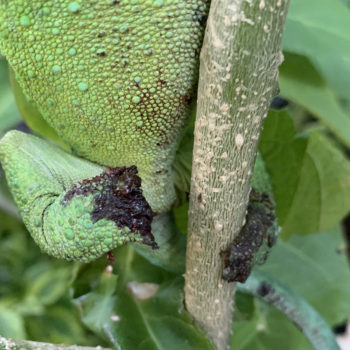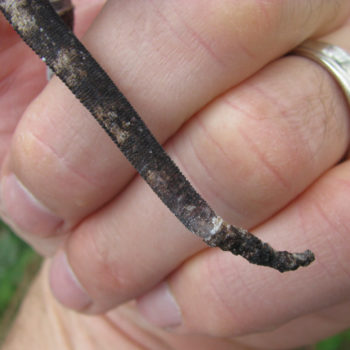Animal Attack
Description
Chameleons suffer bites or even loss of body parts due to attack from another animal. Severity can run the gamut from something as minor as a superficial bite to as traumatic as the loss of a limb. The most common source of attack is from other chameleons living in the same cage. Babies can bite each other or nip tails. Other danger areas include other pets in the home and, finally, wild animals that happen upon your chameleon. From ants to birds to rats, we seem to never run out of animals interested in hunting our chameleons.
Symptoms
Animal attack is easy to determine as damage is external. The chameleon may have a black diamond shaped outline as a result of another baby biting him in a cage scuffle. The chameleon may also, literally, being missing a limb. Rats can easily kill and eat a sleeping chameleon. An ant attack is always a danger as well. Keep in mind that these animals may be attracted to left over feeders and then happen upon the chameleon.
Keeping chameleons outdoors is very beneficial, but added risk comes with that. Birds, rats, opossums, raccoons, snakes, ants, and any number of other animals can wander by and, if your chameleon is sleeping on the side of the cage, it can be attacked.
This chameleon had its tail bitten off. Although horrific, a quick visit to the vet had necrotic tissue removed and the chameleon went on to recover fully. It is amazing how strong chameleons are to physical trauma and how well they recover. If this happens to your chameleon get them to a vet immediately. Do not give up on them! Chameleons can live long lives after losing a tail or limb.
Chameleons can lose horns in fights and in normal rough handling. Horns are very difficult to break off (except for the Meller’s Chameleon horn which is attached only by skin) so there must have been a strong force attached to this loss. The loss of a horn has no effect on quality of life for the chameleon.
Tail Nippping
One of the most common attacks chameleons receive is aggression from chameleons in the same cage. While biting is obvious, a disturbing trend in some chameleons is to bite the tip of the tail off their cage mates. This is most probably done as a dominance play, though some have speculated that the waving of the tip looks enticing. It seems to be certain individuals that engage in tail biting and they become repeat offenders. It is unknown why they do this and why only certain individuals will start this practice.
A tail nip usually heals quickly and without issue. But this kind of aggression is not a healthy living environment and the aggressor must be isolated. The below pictures are of female panther chameleons that were attacked by a tail nipper. They all recovered with only physical imperfections. Depending on the severity, a vet visit may be in order.
Treatment
Treatment will vary with the severity and that is the job of your veterinarian. Generally, the vet will clean the wound, perform any further amputation, and then bandage it for healing.









